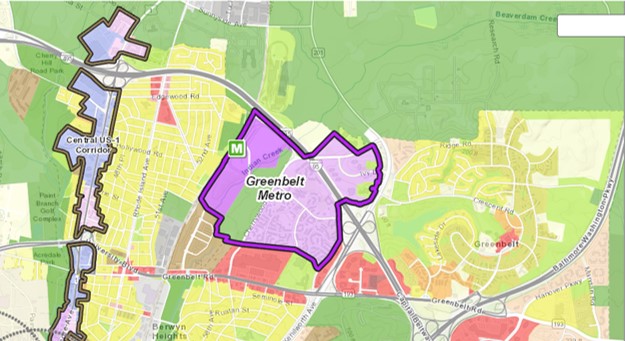This is part one of a two-part series about a recent worksession at which the Greenbelt City Council was briefed on the proposed Prince George’s County zoning changes which will likely be voted on in November, 2020.
Rezoning and the county’s master plan have long been a source of concern for Greenbelt. In particular, zoning of the center of town and Greenbelt Homes Inc. (GHI) are fraught because at various times, rezoning has resulted in development unacceptable to the city but that it was powerless to stop. In Prince George’s County, zoning is in the hands of the county and municipalities can only protest and oppose. At various points in the last 50 years, the voice of the city has been drowned out by actions of the county in approving zoning at densities and for purposes opposed by the city and applauded by developers.
On October 23, 2018, the county council adopted in principle a new master zoning plan but it will not take effect until it is approved by vote, probably in November 2020. During the interim, there is a process called the Countywide Sectional Map Amendment (CMA) that is executed to ensure that the public has the chance to be heard and that conflicts are considered, if not resolved. The rezoning affects some 320,000 households, although Chad Williams from the county planning office, who gave the briefing, was at pains to note that 97 percent of all properties map one to one to the new classifications. There will be about 300 meetings with stakeholders for outreach and education – this is in addition to earlier sessions, public hearings and planned mailings. Williams congratulated Greenbelt on being the first to request a briefing, continuing its unbroken record of such firsts.
Williams pointed listeners to the county’s rewrite website (pgccouncil.us/589/Zoning-Ordinance-Rewrite-Portal) as a source of additional information. It has numerous resources and links to relevant documents and tools as well as answers to frequently asked questions.
Williams went on to state that in fulfilling its mandate of zoning for the 21st century, the county has developed a streamlined and concise plan explained in a “highly readable” document which described it as being couched in language comprehensible to ordinary people and not needing a lawyer for interpretation. The radical concept is that people should be able to look at the zoning map and understand immediately to what purposes any specific property can be put.
Web-based Tool
Also available on the site is a tool, zoningpgc.pgplanning.com/zoning-swipe-tool/, that allows direct comparison of existing zones with the currently anticipated zones. By sliding the vertical bar to the left, the existing zoning is revealed; sliding the bar to the right shows the new zoning. A right click on any area of the map explains the color coding of each zone for new or old zones, depending on which is showing. The map is high resolution, allowing the examination of even the smallest parcels.
Logical Framework
Williams averred that each new zone has a logical purpose and is in a logical and consistent framework. There are fewer zones and they are accompanied by high quality design standards that will apply across the county. These include green building design standards and open space set asides that will apply to most developments. Updates to existing zoning requirements like signage and parking will bring them “into the 21st century.”
Availability of Information
Councilmember Rodney Roberts noted that some Greenbelt East residents were concerned that housing density would get higher, although Williams rebutted this by saying that existing residential developments would not increase in density. Mayor Pro Tem Judith Davis noted, however, that densities were already high, and though existing residential areas are unlikely to become higher density, she hypothesized that the bigger danger was that local commercial zoning would become mixed use – permitting the construction of dwellings in areas now specifically commercial, i.e. which exclude housing – effectively significantly increasing the number of dwellings that could be built in Greenbelt.
Williams mentioned that commercial sites under an acre that are surrounded by residential housing will map to a Commercial Neighborhood zone. Most strip malls are too big for this zone and will become a Commercial General Office (CGO) zoning. Roosevelt Center is too big, and is currently zoned Commercial Shopping Center and slated to become CGO (although Greenbelt’s current zoning is governed by an overlay which is under discussion).
Old Greenbelt
Much of the core of Greenbelt is currently covered by the Neighborhood Conservation Overlay Zones (NCOZ) designation. As stated in an article in the August 2, 2018, issue of this newspaper, “Of particular importance for Greenbelt is a determination on NCOZ. According to Division 27-4 Zones and Zone Regulations, the ʻpurpose of the Greenbelt NCOZ is to preserve the development characteristics of the Roosevelt-era New Deal greenbelt community in the city.”’ Williams stated that the process of negotiating NCOZ will begin shortly and will include the cities of Greenbelt, Mount Rainier and possibly Bowie. The area under consideration in Greenbelt includes a variety of different property types and although Greenbelt shares some concerns with the other two cities, the issues and needs are not identical. The process will include an effort to identify what is unique to each city and what can be done in common. According to the interactive map, GHI townhomes are currently under the RT (Residential/Transitional) designation and will map to Residential Single Family – Attached (RSF-A).


